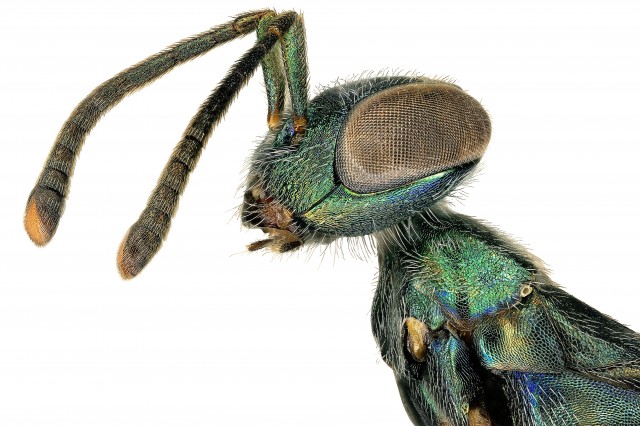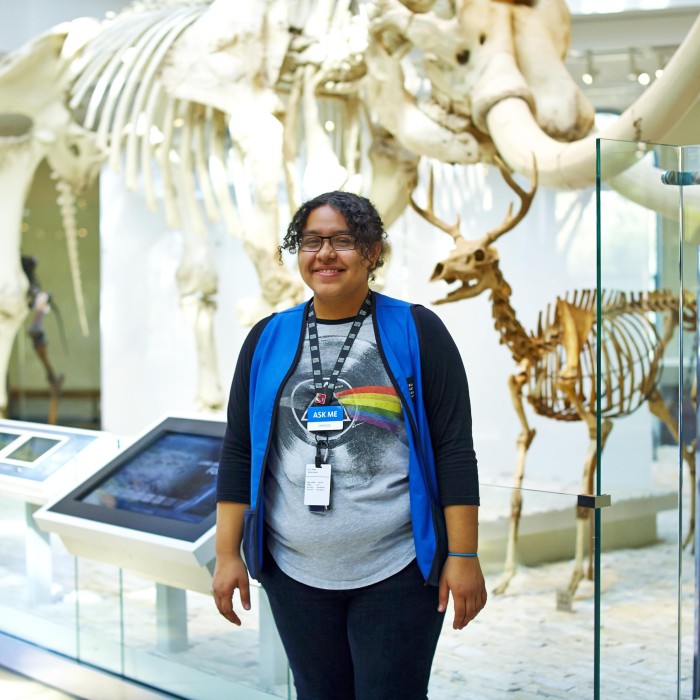Big Bee Bonanza
Help digitize NHM's bee collections and keep bees buzzing with this crowd-sourced community science project
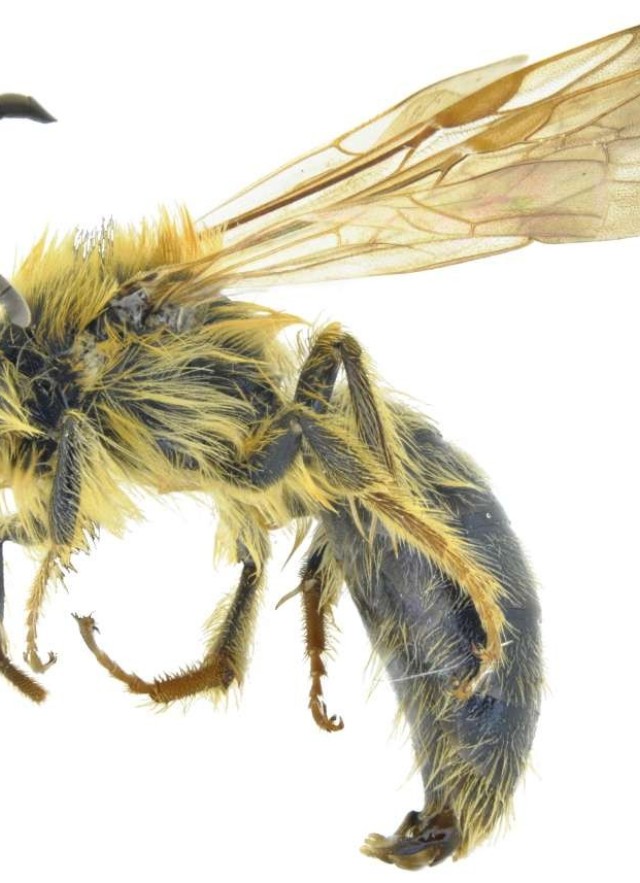
Updated May 17, 2024
Bee populations have been decreasing in numbers and diversity all over the world. Exactly why is a global mystery–but museum collections like NHM's might have some of the answers.
You can help researchers understand just what's happening to these insects that are so crucial to food production in the human and natural worlds in the Big Bee Bonanza by helping to digitize more than a century's worth of bees. In NHM's Entomology Department, this effort is being managed by Collections Manager Giar-Ann Kung who leads the team of imaging specialists working on the project. Together, we can help scientists and policymakers get the data they need to keep bees buzzing.
With your participation in the Big Bee Bonanza! project, we will overcome data limitations for understanding bee biodiversity and decline.
Specimen labels provide information about when and where bees occur, and the measurements give bee researchers an indication of bee body size.
To further explore the NHM collection, there are currently two expeditions in the project: Lovely Leafcutters 1-Measurements and Lovely Leafcutters 2-Transcription. However, we need support with all of the expeditions in the project.
"Like any bee-based initiative, I think ultimately we’re trying to 'Save The Bees', and hopefully this project will let the public literally see that there’s more than just honey bees out there that need saving."
Sylvia Reyes, Big Bee Project Digital Imaging Specialist
"Transcribing and measuring bees on your computer can be an easy, low-commitment way to interact with both the scientific community and the local bee population! No matter where you live or how much time you want to commit to the project, it’s a great way to get a taste of a rarely-exhibited collection."
Kate Ryan, Big Bee Project Digital Imaging Specialist
Explore some of the incredible bee specimens from NHM's Entomology Collection below!

Photo by Sylvia Reyes
Smaller than some of the type on its label, the less than 2-millimeter Perdita minima is the smallest bee known to humans. This specimen from NHM's Entomology collections is dwarfed by the head of a pin. Easily missed by a casual observer, these teeny bees are solitary. They feed on nectar and build nests in the desert sands.
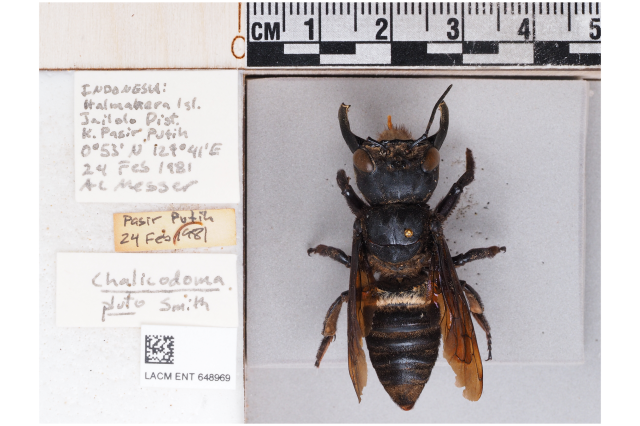
Photo by Sylvia Reyes
On the other side of the size spectrum, the thumb-sized Megachile pluto is the largest bee yet discovered–and rediscovered. First described in 1858, raja ofu (‘the king of bees’ in Indonesian) went unseen by science for over a hundred years after that initial documentation until, and the king of bees was presumed extinct. A 1981 expedition was able to recover specimens, with one landing in NHM’s entomology collection, proving the bee was not extinct. Since then, two specimens have been sold on eBay, and video footage has been recorded, but specimens like NHM’s are otherwise the only records available to scientists. The Big Bee project will make incredibly rare specimens like these more accessible to scientists across the globe.
1 of 1
Smaller than some of the type on its label, the less than 2-millimeter Perdita minima is the smallest bee known to humans. This specimen from NHM's Entomology collections is dwarfed by the head of a pin. Easily missed by a casual observer, these teeny bees are solitary. They feed on nectar and build nests in the desert sands.
Photo by Sylvia Reyes
On the other side of the size spectrum, the thumb-sized Megachile pluto is the largest bee yet discovered–and rediscovered. First described in 1858, raja ofu (‘the king of bees’ in Indonesian) went unseen by science for over a hundred years after that initial documentation until, and the king of bees was presumed extinct. A 1981 expedition was able to recover specimens, with one landing in NHM’s entomology collection, proving the bee was not extinct. Since then, two specimens have been sold on eBay, and video footage has been recorded, but specimens like NHM’s are otherwise the only records available to scientists. The Big Bee project will make incredibly rare specimens like these more accessible to scientists across the globe.
Photo by Sylvia Reyes
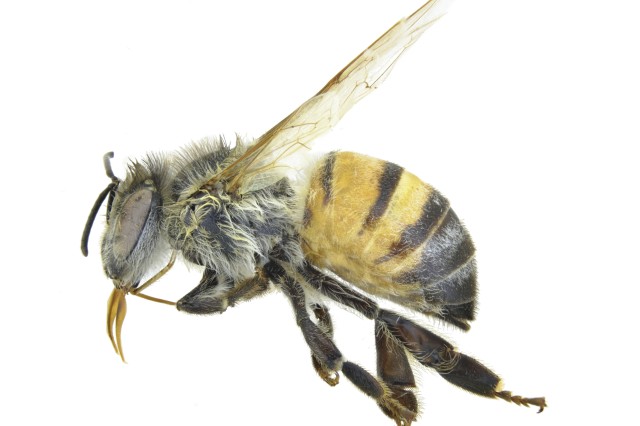
Image by Kelsey Bailey
Apis mellifera is the western or European honey bee we all know. The most common honey bee, this non-native species is probably responsible for your honey, but there are 1,600 species of native bees found in California.
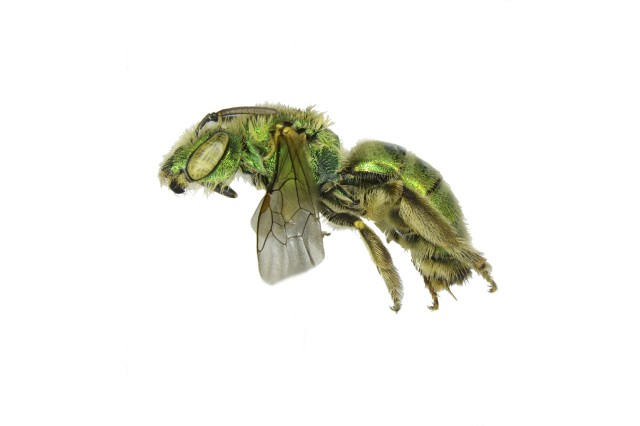
Image by Kelsey Bailey
Sweat bees in the Halictidae family like the one pictured above are named for their tendency to land on our skin for some delicious, mineral-rich sweat. This group of bees carry pollen on their hind legs and sometimes on the underside of their abdomens.

Image by Kelsey Bailey
Mason bees like this beautiful blue Osmia lignaria are named for the mud walls they erect between their egg chambers. They use tubes like the Bee Hotel in NHM's Nature Garden to lay their eggs. These bees gather pollen from local flowers as close to their nests as possible, unlike honeybees that range for miles.
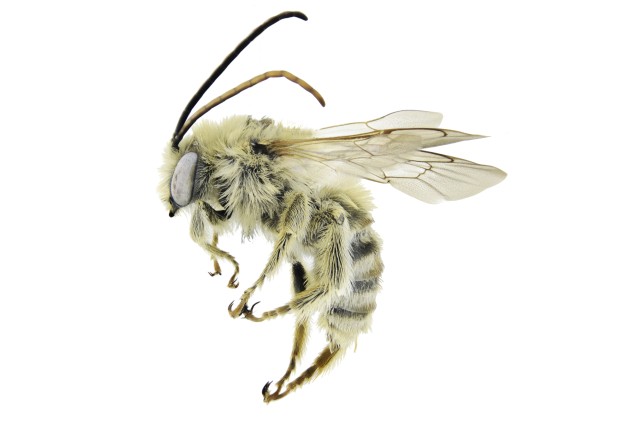
Image by Kelsey Bailey
The impressive antennae like this from the genus Melissodes gives this species their common name: long-horned bees. The males use their impressive headgear to get female attention. While both males and females have hairy legs, only the females have scopae, the branched hairs needed to carry pollen.
1 of 1
Apis mellifera is the western or European honey bee we all know. The most common honey bee, this non-native species is probably responsible for your honey, but there are 1,600 species of native bees found in California.
Image by Kelsey Bailey
Sweat bees in the Halictidae family like the one pictured above are named for their tendency to land on our skin for some delicious, mineral-rich sweat. This group of bees carry pollen on their hind legs and sometimes on the underside of their abdomens.
Image by Kelsey Bailey
Mason bees like this beautiful blue Osmia lignaria are named for the mud walls they erect between their egg chambers. They use tubes like the Bee Hotel in NHM's Nature Garden to lay their eggs. These bees gather pollen from local flowers as close to their nests as possible, unlike honeybees that range for miles.
Image by Kelsey Bailey
The impressive antennae like this from the genus Melissodes gives this species their common name: long-horned bees. The males use their impressive headgear to get female attention. While both males and females have hairy legs, only the females have scopae, the branched hairs needed to carry pollen.
Image by Kelsey Bailey

